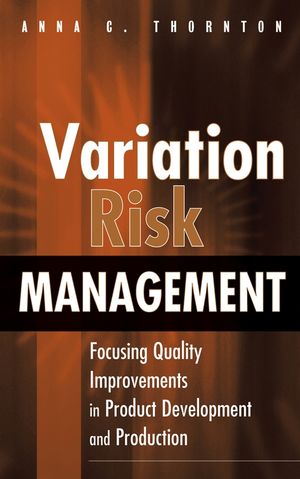Variation Risk Management: Focusing Quality Improvements in Product Development and ProductionISBN: 978-0-471-44679-8
Hardcover
320 pages
November 2003
 This is a Print-on-Demand title. It will be printed specifically to fill your order. Please allow an additional 10-15 days delivery time. The book is not returnable.
|
||||||
Figures.
Tables.
Text Boxes.
Nomenclature.
Acronyms.
1. Introduction.
1.1. The Competitive Advantage of VRM.
1.2. Guide to Readers.
2. Basics of Variation Risk Management.
2.1. Basic Principles of VRM.
2.1.1. VRM Must Be Holistic.
2.1.2. VRM Must Be Process Oriented.
2.1.3. VRM Must Be Data Driven.
2.2. Variation and Its Impact on Quality.
2.3. Summary.
3. Identification.
3.1. Definition of Key Characteristics and Variation Flowdown.
3.1.1. Key Characteristics.
3.1.2. Variation Flowdown.
3.2. Defining the Scope of the VRM Application.
3.3. Identifying Critical System Requirements.
3.3.1. Identify the Voice of the Customer.
3.3.2. Identify Specifications and Requirements.
3.3.3. Identify Critical System Requirements.
3.4. Identifying System Key Characteristics.
3.4.1. What Is a System Key Characteristic?
3.4.2. Examples of System Key Characteristics.
3.5. Creating the Variation Flowdown.
3.5.1. What Information to Gather.
3.5.2. How to Conduct the Top-Down Process.
3.5.3. How to Conduct the Bottom-Up Process.
3.5.4. How to Conduct and Document the Identification Procedure.
3.6. Summary.
4. Overview of Assessment.
4.1. Assessment during Product Development.
4.2. Assessment during Production.
5. Assessment of Defect Rates.
5.1. Predicting the Frequency of Defects.
5.1.1. Variation Models.
5.1.2. Prediction Tools.
5.2. Estimating the Contributions of Part and Process KCs.
5.2.1. Qualitative Analysis of Variation Contribution.
5.2.2. Quantitative Analysis of Variation Contribution.
5.3. Measuring the Frequency of Defects.
5.4. Measuring the Contributions of Part and Process KCs.
5.5. Summary.
6. Assessment of Cost and Risk.
6.1. Cost and Risk Assessment during Product Development.
6.1.1. Qualitative Assessments.
6.1.2. Step Cost Functions.
6.1.3. Continuous Cost Functions.
6.2. Total Cost of Variation Assessment during Production.
6.2.1. Cost Sources.
6.2.2. Representation of the Total Cost of Variation.
6.2.3. Cost Analysis and Aggregation.
6.3. Summary.
7. Assessment of the Quality Control System.
7.1. QC Plan Maturity.
7.1.1. Detection Capability and Effectiveness.
7.1.2. Diagnosis Capability.
7.1.3. Efficient Resource Utilization.
7.2. QC Location in the Manufacturing Process.
7.3. QC Effectiveness Matrix.
7.4. Summary.
8. Mitigation.
8.1. Mitigation during Product Development and Production.
8.1.1. Mitigation during Product Development.
8.1.2. Mitigation during Production.
8.2. Identifying Mitigation Strategies.
8.2.1. Design Changes.
8.2.2. Manufacturing Process Changes.
8.2.3. Manufacturing Process Improvements.
8.2.4. Monitoring and Controlling Manufacturing Processes.
8.2.5. Testing and Inspection.
8.3. Selecting a Mitigation Strategy.
8.4. Selecting a Project Portfolio.
8.5. Executing Mitigation Strategies.
8.6. Summary.
9. Integration of Variation Risk Management with Product Development.
9.1. Basics of Product Development.
9.1.1. Stage Gate Product Development Process.
9.1.2. VRM during Product Development.
9.1.3. Metrics.
9.2. Requirements Development.
9.3. Concept Development.
9.4. Product Architecture Design.
9.5. System Concept Design.
9.6. Detail Design.
9.7. Product Testing and Refinement.
9.8. Transition to Production.
9.8.1. Handling Customer Complaints.
9.8.2. Wrap-Up.
9.8.3. Documenting the Key Characteristic Plan.
9.9. Production.
9.9.1. Continually Monitor Total Cost of Variation.
9.9.2. Track Customer Complaint Data.
9.9.3. Review Quality Control Data.
9.9.4. Track Impact of Changes.
9.10. Summary.
10. Roles and Responsibilities in Variation Risk Management.
10.1. Product Development.
10.1.1. The Integrated Product Team Approach.
10.1.2. Expert Teams.
10.1.3. Coaches.
10.2. Production.
10.2.1. Production Teams.
10.2.2. Expert Teams.
10.3. Suppliers’ Roles and Responsibilities.
10.3.1. Role of Suppliers during Product Development.
10.3.2. Role of Suppliers during Production.
10.3.3. What Does a KC Mean to a Supplier?
10.4. Summary.
11. Planning and Implementing a Variation Risk Management Program.
11.1. Planning a VRM Program.
11.1.1. Gathering Management Support.
11.1.2. Gathering Organizational Support.
11.1.3. Baselining the Existing VRM Processes.
11.1.4. Formalizing VRM.
11.1.5. Developing KC Tracking Methods.
11.1.6. Identifying Lead Users.
11.1.7. Developing Training Materials.
11.2. Implementing the VRM Program.
11.2.1. Identifying Initial Projects.
11.2.2. Training the Team.
11.2.3. Applying VRM.
11.2.4. Gathering Feedback.
11.3. Summary.
12. Summary.
Appendix A: Maturity Models.
Appendix B: Process Capability Databases.
B.1. Background on Process Capability Data.
B.1.1. Importance of Using Process Capability Data.
B.1.2. Structure and Content of a Process Capability Database.
B.1.3. Difficulties in Implementing Process Capability Databases.
B.2. The Right Structure.
B.2.1. Designing the Indexing Scheme.
B.2.2. Choosing the Database Implementation Approach.
B.2.3. Creating the User Interfaces and Data Analysis.
B.3. The Right Data.
B.4. The Right Management Support.
B.5. The Right Usage.
B.6. Implementation of a Process Capability Database.
B.6.1. Who Should Be Involved.
B.6.2. What Decisions Should Be Made.
B.6.3. Implementation Steps.
B.7. Summary.
Appendix C: Other Initiatives.
C.1. Six Sigma.
C.2. Design for Six Sigma.
C.3. Lean Manufacturing.
C.4. Continual Improvement, TQM, and Kaizen.
C.5. Dimensional Management.
C.6. Design for Manufacturing.
C.7. Quality Function Deployment (House of Quality).
C.8. FMEA.
C.9. Summary.
Appendix D: Summary of Process Diagrams.
Glossary.
Bibliography.
Index.



